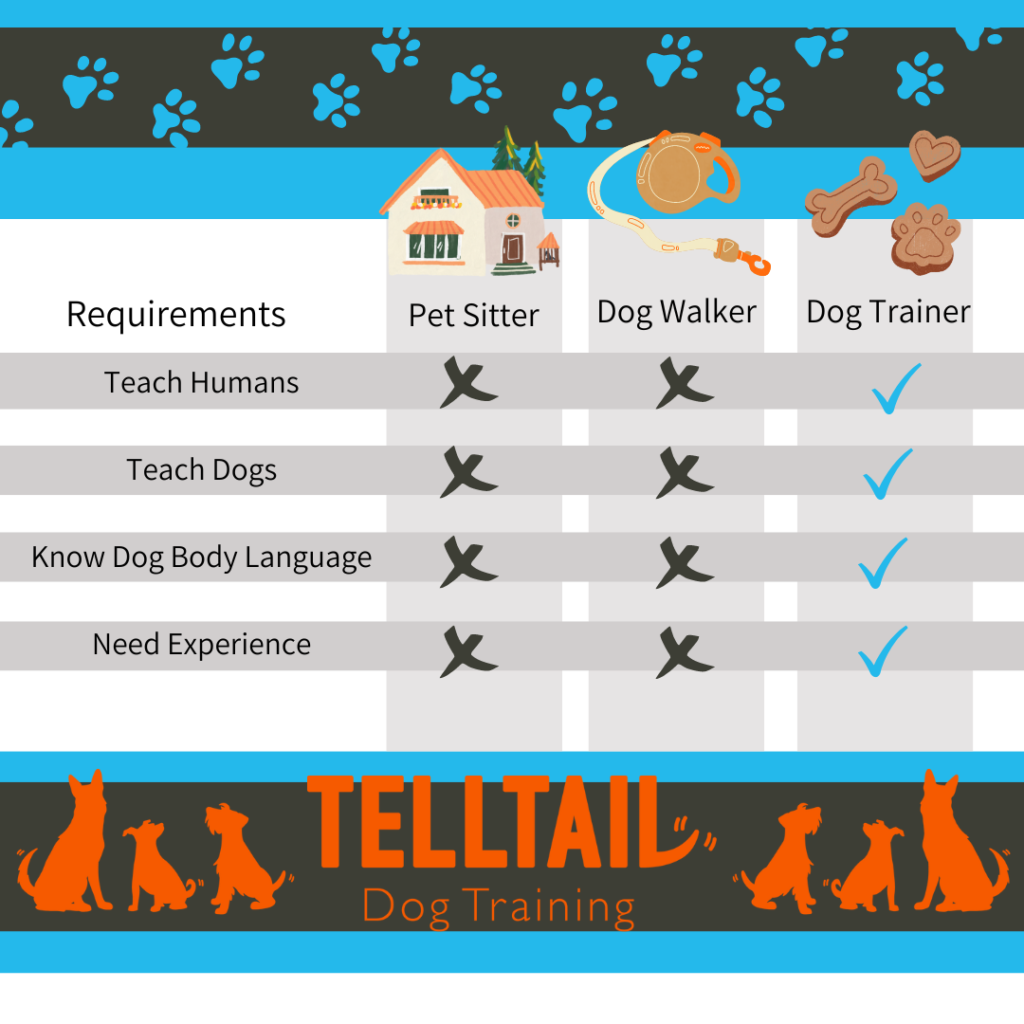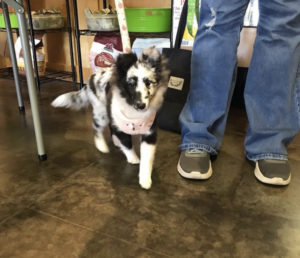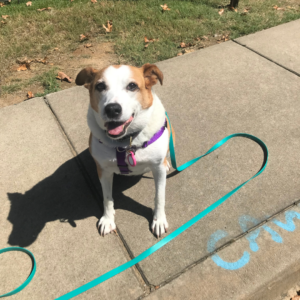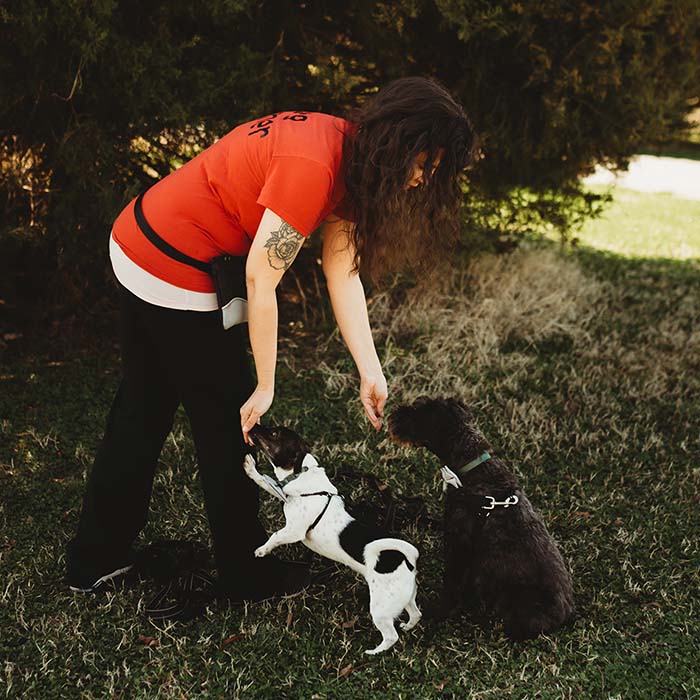I was asked recently if a dog walker was the same as a dog trainer. Dog trainers aren’t dog walkers. But they can be.
A dog trainer is someone who teaches cues to or modifies behavior with dogs. Often, this includes their people in group classes or private lessons. Dog trainers can also offer dog walking and petsitting.
A dog walker is someone who walks dogs, typically mid-day, for enrichment and/or potty breaks. A dog walker can know how to teach leash manners to a dog, for example, but this is not required to be a dog walker.
A petsitter is someone who either spends overnight at a dog’s or cat’s home or visits a pre-determined amount of times to provide care and potty breaks. This can include walks. Dog walkers often provide this service.
Dog walkers are important, especially for folks with busy schedules or mobility challenges. But dog walkers aren’t dog trainers. They can know a lot about training and there can be a lot of overlap. But a dog walker doesn’t have to know how to train or even know a lot about dogs to be a good dog walker. It’s an easy way to step into the pet world, and folks can remain dog walkers or build from there into dog training. Dog walkers aren’t always petsitters either, although they can be.
Dog trainers and other dog professionals like groomers require a higher level of knowledge and experience to do their jobs effectively. Veterinarians, veterinary technicians, behavior consultants, and behaviorists all need much higher levels of official education, including post-grad work, to be able to do their work, which includes laws and regulation that dog trainers and dog groomers don’t have.

I started my pet career as a petsitter, after I got Jeeves in 2012. I hung out with my boss’s two border collies and my friend’s lab mix. Because I was working as a marketing consultant making my own schedule, I could also go around my little neighborhood and collect the neighbors’ dogs to play with Jeeves in the park behind our houses. I would grab the border collie mix and the shedding black lab mix that was supposed to be a non-shedding doodle.
The park was nestled up against a steep hill on one side, the houses on the other side, and a long entrance way towards the main road, so there was a natural border that contained everyone. When I moved to New Jersey, I would take care of four Yorkies now and then, and a 16-year-old blind and deaf Maltese.
I found a dog walking gig in 2016 that I worked for six months, which was just enough to give me a bit more of a pet resume for when I applied to a dog training internship in 2017.
I didn’t have a difficult dog. I’d just always wanted to work with animals. I just didn’t know how to do it or if it was even possible.
And after years of petsitting, I thought I knew a lot about dogs. And maybe I knew more than the average person, with all of my research and experience. But when I became a dog trainer, I became painfully aware of how little I knew and how many misconceptions I held.
It took six months of hands-on experience with different dogs every day at the farm with Philly Unleashed and assisting four to six classes a week, along with learning everything I could from books and videos, to finally step into the title of dog trainer. Everything clicked and I was able to train with a fluidity I didn’t have previously. My skills and knowledge have continued to improve every day, but I’m still painfully aware of how much more I need to learn.
What makes me different than a groomer, dog walker or petsitter is skill and knowledge. That doesn’t mean I’m better than a groomer, dog walker or petsitter, but that our expertise and experiences are different. There can be overlap, absolutely. A dog walker may have some great techniques to prevent pulling, for example. And I have no idea how to groom a dog, with no interest in learning. It is an incredibly skilled job with its own set of challenges. What I can do, however, is train cooperative care to make grooming easier.
Note: These are not even a fraction of the available careers and gigs and jobs available in the pet industry. These are just the most common ones, outside of the medical field, like veterinarians or veterinary technicians.
To become a dog trainer, I had to learn a lot of different cues and how to adjust and teach them to a variety of different dogs, including differences in size, breed, ability, and interest. I also had to learn how to teach humans how to handle their own dogs, and, since we did open classes with no set schedule, I had to learn how to plan curriculum on the fly and adjust to the dog and person in front of me. We had set cues we worked through, but we adjusted the content to each class, as we typically didn’t see the same dogs each week
I had to learn dog body language, which helped me adjust behavior and work with aggressive and nervous dogs to prevent bites. I learned that some dogs don’t like being touched, and some only prefer being pet on certain parts of their bodies. I learned how suble dog expressions can be, and that a lip lick or a yawn can be a nervous movement or a precursur to more extreme aggression displays.
I had to learn how to write and develop training plans, how to talk to clients in person, by the phone, and via email. I had to do a lot of physical labor, like cleaning up a lot of poop.
I had to learn about equipment, like harnesses and haltis and leashes. I had to learn how to make adjustments if dogs were heavy pullers or reactive. I had to learn about the different types of reactivity.
I had to learn how dogs retain information and respond and what reinforcers are.
I had to learn how to record myself on video and edit the video and post to social media. This was a challenging skill to lean, but incredibly helpful in growing my skillset, both as a trainer and in media.
I also learned how I could connect my previous skills in communication and storytelling to the dog industry, and I took on the newsletter and client spotlights.
Now, I offer three main services:
- Private Lessons
- Group Classes
- Training Walks
With private lessons, I have to be able to find potential clients, talk to them about their needs, schedule, show up to their home, gather additional information (including what they’ve already tried, what their dog knows, etc.), explain how dogs learn, discuss body language, the foundations of training, and get them started on the training plan. I also have to write and maintain the training plan, along with additional resources as needed. I have to maintain relationships with them and continue to schedule and follow up. If I’m not able to help, or behaviors develop that are beyond my expertise, I have to know when to refer out and the best person to refer to.
This means developing and maintaining relationships with other dog trainers, behavior consultants, and behaviorists. I do this mainly through my podcast, which I schedule for, interview for, edit audio (and video if possible), post to all channels, and market on social media.
Podcasting, writing blog posts, and growing my social media through graphics and reels aren’t required to be a good dog trainer, but they’ve been fundamental in growing my business. I still use the same blog posts I wrote in 2020, and they’re a part of any inquiry so folks can know and understand my methods and how I approach training.
With group classes, I have to be able to manage a group of people and between four to six dogs. I have to develop and execute curriculum, and adjust it as needed, often in the moment. Sometimes classes will blow quickly through what I have planned, and I have to figure out additional material immediately. I typically explain the cue we’re working on, why we’re working on it, what it is useful for, and then I demonstrate it with a dog in the class, then come around to each set of people and dogs and observe and adjust if needed. I am constantly developing new classes and curriculum, and I am currently writing curriculum for online classes.
With training walks, I have to grow on skills for individual dogs, record myself training, and explain to the owner what we did and how to practice it. I have to keep moving the dogs along on their training plan and track each where they are.
And I didn’t even touch on specialties, like service dogs, kids and dogs, sports, trick training, herding, personal protection, and more. There is always so much to learn, and I’ve found that dog trainers can usually successfully be experts in about 1-3 areas of training, but not experts in all areas equally. For example, someone who is a really skilled service dog trainer may also specialize in reactivity, but they may not also be really good at separation anxiety while knowing aspects of it. Most skilled trainers tend to have general understanding and skill for a variety of different needs, but not necessarily in-depth expertise in a bunch of different areas.
I also didn’t delve into the different types of dog trainers and the methods they use. That’s here. What I explained above is how I learned to work, and how I enjoy working. I truly love what I do, and I’m always trying to find ways to be a better person and dog trainer.
To start as a dog trainer, however, all someone has to do is being able work with a bunch of different dogs teaching basic skills. Some of the easiest ways to do that are to volunteer with rescues or shelters. And getting a job with a petsitting or dog walking company or starting your own is also a great way to get experience. I’m always referring to other dog trainers, behavior experts, dog walkers, petsitters, and groomers. We need more trainers, sitters, and walkers who are ethical and kind and love animals (and people).



